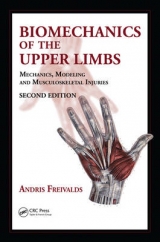
Biomechanics of the Upper Limbs
Taylor & Francis Ltd (Verlag)
978-0-7484-0926-6 (ISBN)
- Titel erscheint in neuer Auflage
- Artikel merken
The repetitive tasks of various forms of manual work can lead to cumulative trauma disorders, increasing staff burn-out rates and the number of sick-days taken by employees. In addition, interest in upper extremity musculoskeletal disorders has grown as the service sector has claimed a larger share of the workforce. These factors introduce the need for an up-to-date text that combines basic biomechanics with practical bioengineering issues.
Biomechanics of the Upper Limbs: Mechanics, Modeling, and Musculoskeletal Injuries is an engineering oriented book focusing on upper extremity musculoskeletal disorders, as opposed to the more general introductions to cumulative trauma disorders and medical management related books. It covers musculoskeletal components of the upper extremities, their models, and the measurement and prediction of injury potential. Students and professionals will find it provides an excellent basic grounding in the subject.
Topics include:
A basic introduction to biomechanical principles
Gross structure of the musculoskeletal system, including bone and soft tissue
Organization of muscles and muscle anatomy, types of fibers, contractile theories, and muscle receptors
Modeling of muscle mechanics
Models of the upper limbs
Types of musculoskeletal disorders and the scientific evidence for risk factors, as well as epidemiology
Instrumentation for motion, pressure, force and nerve conduction measurements, and electromyography
Job and worksite analysis
Hand tools
Office environment seating and computer devices
INTRODUCTION TO BIOMECHANICS
What is Biomechanics?
Basic Concepts
Coordinate Systems
Force Vector Algebra
Static Equilibrium
Anthropometry and Center of Mass Determination
Friction
Dynamics
STRUCTURE OF THE MUSCULOSKELETAL SYSTEM
Gross Overview of Movements
The Skeletal System
Mechanical Properties of Bone
Soft Connective Tissue
Joints
NEUROMUSCULAR PHYSIOLOGY AND MOTOR CONTROL
Introduction to Musculature
Structure of Muscle
Basic Cell Physiology
The Nervous System
The Excitation-contraction Sequence
Motor Units
Basic Muscle Properties (Mechanics)
Energy, Metabolism and Heat Production
Receptors
Reflexes and Motor Control
MODELING OF MUSCLE MECHANICS
Laplace transforms and Transfer Functions
Viscoelastic Theory
Hill's Muscle Models
Frequency Analysis
Frequency Analysis of Passive Muscle
Hatze's Multi-element Model
Applications of the Hatze Muscle Model
Control Theory and Motor Control
Root Locus Approach to Muscle Modeling
MODELS OF THE UPPER LIMBS
Anatomy of the Hand and Wrist
Static Tendon-Pulley Models
Dynamic Tendon Pulley Models
Complex Tendon Models
A Two-dimensional Hand Model
Direct Measurement Validation Studies
Critical Evaluation of Modeling Approaches
MUSCULOSKELETAL DISORDERS AND RISK FACTORS
The Extent of the Problem
Common Musculoskeletal Disorders and their Etiology
Medical Diagnosis and Treatment of MSDs
Epidemiologic approach to MSDs
The Scientific Research and Evidence for Occupational Risk Factors
The Scientific Research and Evidence for Psychosocial Risk Factors
Iatrogenesis
INSTRUMENTATION
Introduction
Wrist and Finger Motion Measurement
Pressure and Force Distribution Measurements
Nerve Conduction Measurements
Electromyography
JOB AND WORKSITE RELATED ANALYSIS
The Need for Job Analysis
Reliability and Validity of Assessment Tools
Initial Identification of Musculoskeletal Injury Problems
Gross Posture and Task Analyses
Quantitaive Upper Limb WRMSD Risk Assessment Tools
Data Driven Upper Limb WRMSD Risk Index
HAND TOOLS
Introduction
General Biomechanical Considerations of Tools
Handles for Single-handled Tools
Handles for Two-handled Tools
Other Tool Considerations
Agricultural and Forestry Tools
Industrial Tools
THE OFFICE ENVIRONMENT
General Musculoskeletal Problems
The Seated Workplace
The Keyboard
The Mouse and Other Cursor-positioning Devices
Notebooks and Hand-held PCs
Control Measures
Glossary
Author Index
Subject Index
Each chapter also includes questions, problems, and references
| Erscheint lt. Verlag | 29.6.2004 |
|---|---|
| Zusatzinfo | 550 equations; 71 Tables, black and white; 241 Illustrations, black and white |
| Verlagsort | London |
| Sprache | englisch |
| Maße | 156 x 235 mm |
| Gewicht | 998 g |
| Themenwelt | Medizin / Pharmazie ► Medizinische Fachgebiete ► Arbeits- / Sozial- / Umweltmedizin |
| Studium ► 1. Studienabschnitt (Vorklinik) ► Physiologie | |
| Technik | |
| Wirtschaft | |
| ISBN-10 | 0-7484-0926-2 / 0748409262 |
| ISBN-13 | 978-0-7484-0926-6 / 9780748409266 |
| Zustand | Neuware |
| Haben Sie eine Frage zum Produkt? |
aus dem Bereich



